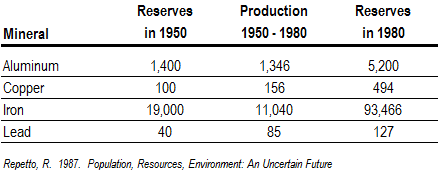-
- 05 Jun
Exploiting the World’s Non-renewable Resources
If you mine and burn some non-renewable resource – oil, gas, coal – to run your car on, or make electricity with, are you unfairly exploiting the world’s resources to the detriment of future generations?
This is a common perception.
The idea isn’t new. In the 19th century many people in England were worried about over-reliance on coal whose reserves were limited. The concern was that when the coal ran out so too would the British standard of living. In 1865 an English economist, William Stanley Jevons, published a paper titled “The Coal Question” to address this. He advocated restraint.
Britain did not follow his recommendations. Indeed coal production was increased. Production was 102 million tonnes in 1865. 100 years later it was nearly double that amount – 192 million tonnes. And, despite two world wars the standard of living in Britain did not collapse.
The reasons that Jevons was wrong also apply today for coal, oil, gas, and any other commodity.
Here’s why:
It is undeniable that the earth’s natural resources are finite. The world’s known reserves of copper, for example, equate to about 35 years of mining at current production rates. Most of the important mineral commodities used in the world have a similar limited future from this perspective, with some precious metals such as silver, for example, having reserves of less than 15 years at current production rates.
However “known reserves” are not the same thing as actual resources in the ground, or even economically recoverable resources. Resources have to be found, drilled out, evaluated, and eventually turned into known reserves.
The table lists the reserves of four important minerals in 1950 and 1980, compared to the production during the same period.
World Reserves and Cumulative Production of Selected Minerals
(millions of tonnes of metal content)
Even though production in the 30 years following on from 1950 exceeded, or nearly exceeded, the reserves available at that time, the reserves at the conclusion of the 30-year period far outweighed the reserves at the start. The trend applies for most commodities not just in total terms, but also in “years of production” terms.This trend has almost nothing to do with the physical commodities. It exists because of simple economics.
Exploring for and proving up reserves is costly. It is uneconomic to spend money now to prove up reserves too far into the future, because the return from exploiting them only materialises when they are extracted in the future.
World oil reserves today, for example, equate to about 34 years at current production rates (or more, according to some estimates). It would certainly give everyone more comfort if reserves extended (say) 60 or more years into the future. But what company can justify spending even $5 per barrel to prove up more oil now, in the knowledge that the oil won’t be exploited until 2070 or later? Even at an historically low discount rate of (say) 4%, an expenditure of $5 today equates to $52/barrel in future price terms … more than the current price of oil (mid-2016). Thus this investment in exploration is uneconomical from the start, before even accounting for the costs of bringing the oil into production. The value of the expected return 60 years into the future when discounted to today simply makes exploration uneconomical.
How far into the future reserves are known is a function of how costly it is to prove up the reserves as a proportion of the costs of extraction. Silver has limited reserves (in comparison to annual production rates) because orebody delineation is a relatively high cost in typical silver deposits. In contrast, coal has a relatively low delineation cost as a proportion of the costs of extraction. It is not surprising then that coal has a reserve position at more than 100 years at current production rates.
As the cost of proving up reserves increases in proportion to the total production cost, the reserve position in terms of “years into the future” will decline, but this says nothing about the total amount of mineral in the ground, sustainable annual production rate, or when the reserves will be exhausted – if ever.
For sure, any individual deposit and extraction method has limiting production rates, and it is common for production to peak and thereafter decline. Sometimes the extraction method can be changed – production operations can be recapitalized – and production can reach new peaks followed of course then by decline. But what happens with any one deposit doesn’t translate into the resources industry as a whole, which is always finding new reserves and deploying new technologies.
In the case of oil, commentators frequently refer to “Peak Oil” – erroneously equating production changes in individual deposits or groups of deposits to what happens in the industry as a whole. The US shale-oil industry is an example of new reserves and new technologies disrupting the status quo. Conventional oil production might have peaked and be in decline, but for the industry as a whole, the notion of “Peak Oil” [or “Peak Copper” in the case of the copper industry, or “Peak Gold” in the case of the gold industry] is completely false.
The world will not run out of non-renewable commodities.
As commodities become scarce, won’t the real price be ever-increasing? For discussion on this issue, see the companion article: Will we be able to afford the cost of commodities in the future?
About the Author
IanRunge
https://ianrunge.com





